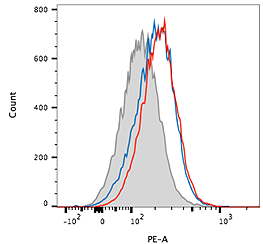
Detection of endogenous mouse LRP5/6 using anti-LRP5/6, mAb (rec.) (Heldy-1-4) (Prod. No. AG-27B-0019). Method: B16 melanoma mouse cells were stained with anti-LRP5/6, mAb (rec.) (Heldy-1-4) (blue and red lines) (1/100 in PBS + 2% FCS) or
anti-LRP5/6, mAb (rec.) (Heldy-1-4)
AG-27B-0019
ApplicationsFlow Cytometry
Product group Antibodies
ReactivityHuman, Mouse
TargetLrp5
Overview
- SupplierAdipoGen Life Sciences
- Product Nameanti-LRP5/6, mAb (rec.) (Heldy-1-4)
- Delivery Days Customer10
- ApplicationsFlow Cytometry
- CertificationResearch Use Only
- ClonalityMonoclonal
- Clone IDHeldy-1-4
- Concentration1 mg/ml
- Estimated Purity>95%
- Gene ID16973
- Target nameLrp5
- Target descriptionlow density lipoprotein receptor-related protein 5
- Target synonymsBMND1, HBM, LR3, LRP7, OPPG, mKIAA4142, low-density lipoprotein receptor-related protein 5, LRP-5, LRP-7, low-density lipoprotein receptor-related protein 7
- HostHuman
- IsotypeIgG2
- Protein IDO88572
- Protein NameLow-density lipoprotein receptor-related protein 6
- Scientific DescriptionRecombinant Antibody. Recognizes human and mouse LRP5 & LRP6. Species cross-reactivity: Human, Mouse. Clone: Heldy-1-4. Isotype: Human IgG2lambda. Applications: FACS. Host: HEK 293 cells. Liquid. In PBS containing 10% glycerol. Wnt/beta-catenin signaling acts as a regulator of tissue development and homeostasis. Wnt ligands bind to a member of the Frizzled family of seven-transmembrane proteins and to either highly homologous low-density lipoprotein related receptors 5 (LRP5) or LRP6. Low-density lipoprotein receptor-related protein 6 (LRP6) is a member of the low-density lipoprotein receptor (LDLR) family. LRP5 and LRP6 are expressed in most human tissues and is composed of three distinctive cell-surface protein domains, including (1) LDL receptor (LDLR) type A repeats; (2) an epidermal growth factor (EGF)-like domain; and (3) a YWTD (Tyr-Trp-Thr-Asp)-type beta propeller domain. LRP6 is inhibited by the Dickkopf protein Dkk1 bound to their partners Kremen. Sclerotin also acts as an inhibitor of LRP5/6 through LRP4. LRP6 is involved in cell differentiation, proliferation and migration during embryonic development and in the pathogenesis of different cancer types. LRP6 plays a major role in metabolic regulation, specifically in the nutrient-sensing pathway. Patients carrying an LRP6 mutation exhibit high serum LDL cholesterol and triglycerides, hypertension, high fasting blood glucose levels, a prevalence of diabetes and low bone density. LRP6 mutations have also been associated with diseases such as Alzheimers and degenerative joint diseases. LRP5, low-density-lipoprotein-receptor-related protein 5, is a determinant for bone mineral density and plays a role in osteoporosis. LRP5 is aso involved in vitreoretinopathy. - Wnt/beta-catenin signaling acts as a regulator of tissue development and homeostasis. Wnt ligands bind to a member of the Frizzled family of seven-transmembrane proteins and to either highly homologous low-density lipoprotein related receptors 5 (LRP5) or LRP6. Low-density lipoprotein receptor-related protein 6 (LRP6) is a member of the low-density lipoprotein receptor (LDLR) family. LRP5 and LRP6 are expressed in most human tissues and is composed of three distinctive cell-surface protein domains, including (1) LDL receptor (LDLR) type A repeats; (2) an epidermal growth factor (EGF)-like domain; and (3) a YWTD (Tyr-Trp-Thr-Asp)-type beta propeller domain. LRP6 is inhibited by the Dickkopf protein Dkk1 bound to their partners Kremen. Sclerotin also acts as an inhibitor of LRP5/6 through LRP4. LRP6 is involved in cell differentiation, proliferation and migration during embryonic development and in the pathogenesis of different cancer types. LRP6 plays a major role in metabolic regulation, specifically in the nutrient-sensing pathway. Patients carrying an LRP6 mutation exhibit high serum LDL cholesterol and triglycerides, hypertension, high fasting blood glucose levels, a prevalence of diabetes and low bone density. LRP6 mutations have also been associated with diseases such as Alzheimers and degenerative joint diseases. LRP5, low-density-lipoprotein-receptor-related protein 5, is a determinant for bone mineral density and plays a role in osteoporosis. LRP5 is aso involved in vitreoretinopathy.
- ReactivityHuman, Mouse
- Storage Instruction-20°C,2°C to 8°C
- UNSPSC12352203
